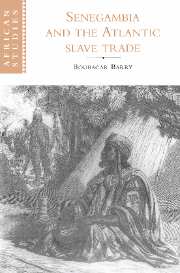Book contents
- Frontmatter
- Contents
- Preface
- Map
- I Senegambia from the fifteenth to the seventeenth century: a haven for incoming populations, a station for migrants on the move
- II Senegambia in the eighteenth century: the slave trade, ceddo regimes and Muslim revolutions
- III Senegambia in the first half of the nineteenth century: legitimate trade and sovereignty disputes
- IV Senegambia in the second half of the nineteenth century: colonial conquest and resistance movements
- 14 Colonial imperialism and European rivalries in Senegambia
- 15 Last-ditch resistance movements of legitimist rulers in northern Senegambia
- 16 The conquest of the Southern Rivers region
- 17 The balancing act of the Almamis of Timbo in their attempts to cope with centrifugal forces
- 18 Bokar Biro and the conquest of Futa Jallon
- 19 Mass resistance movements among the Joola and the Konyagi
- Conclusion
- Notes
- Bibliography
- Index
- Other books in the series
15 - Last-ditch resistance movements of legitimist rulers in northern Senegambia
Published online by Cambridge University Press: 31 October 2009
- Frontmatter
- Contents
- Preface
- Map
- I Senegambia from the fifteenth to the seventeenth century: a haven for incoming populations, a station for migrants on the move
- II Senegambia in the eighteenth century: the slave trade, ceddo regimes and Muslim revolutions
- III Senegambia in the first half of the nineteenth century: legitimate trade and sovereignty disputes
- IV Senegambia in the second half of the nineteenth century: colonial conquest and resistance movements
- 14 Colonial imperialism and European rivalries in Senegambia
- 15 Last-ditch resistance movements of legitimist rulers in northern Senegambia
- 16 The conquest of the Southern Rivers region
- 17 The balancing act of the Almamis of Timbo in their attempts to cope with centrifugal forces
- 18 Bokar Biro and the conquest of Futa Jallon
- 19 Mass resistance movements among the Joola and the Konyagi
- Conclusion
- Notes
- Bibliography
- Index
- Other books in the series
Summary
The defeat of the three main Muslim leaders, coupled with France's retreat after the disastrous defeat of 1870, gave the rulers of northern Senegambia some breathing space. They used it to restore their authority, each within his own state, in the name of a centuries-old tradition of legitimacy.
Lat Joor had again risen to be Damel, thanks to a compromise agreement with the French colony. Now he had to deal with a revolt among the jaami buur, the royal slave army. Their leader, Demba Waar Sal, was gradually taking on the role of main overseer and operative agent of colonial power as the French hold on Senegambia tightened. From 1883 onward, the conflict between Lat Joor and the French over French plans to build a railway line led to an open break. The issue was resolved in 1886 when the Damel was defeated at Dekhele.
Alburi Njaay went through a similar experience. First he regained the Jolof throne using French aid. Then, taking advantage of the remote location of his kingdom, he reinforced his authority, coopting the Muslim revolt that lasted from 1875 to 1890 in the process. After the defeat of Lat Joor, his main ally, Alburi Njaay tried to work out a Tijaniyya alliance with Saer Maty of Rip and Abdul Bokar Kane of central Futa. Still he had to abandon Yang Yang to the French.
- Type
- Chapter
- Information
- Senegambia and the Atlantic Slave Trade , pp. 223 - 242Publisher: Cambridge University PressPrint publication year: 1997



